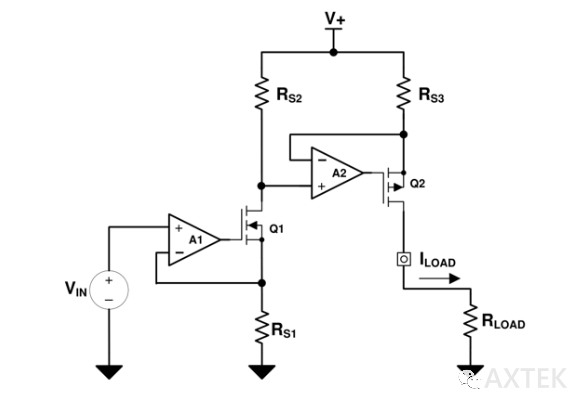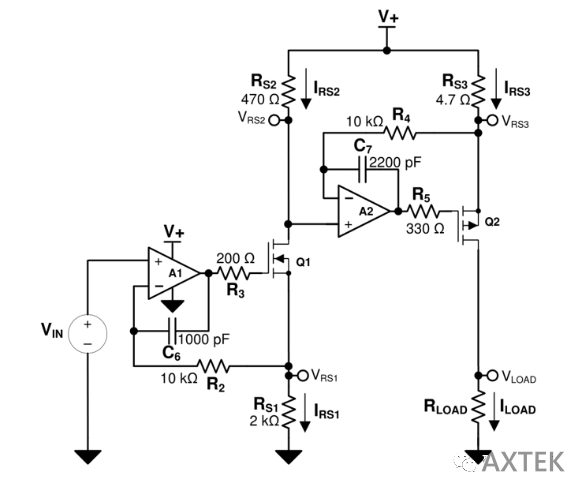Voltage-to-current (V/I) conversion circuits are widely used in industrial environments, especially in 4–20 mA current loop systems. In this article, we will walk through the working principle and practical design of a high-side V/I converter circuit with a real-world example.
1. Principle of High-Side V/I Converter

This high-side V/I conversion circuit provides a controllable current to a grounded load. It consists of a two-stage architecture:
Stage 1: Converts the input voltage (VIN) into a current reference using an op-amp and NMOS.
Stage 2: Uses a second op-amp to control the gate of a PMOS, thereby regulating the output current to the load.
The V-I transfer function is determined by the relationship between the input voltage VIN and three current-sensing resistors RS1, RS2, and RS3:
Stage 1:
VRS1=VIN→IRS1=RS1VIN
Stage 2:
IRS2≈IRS1,VRS3≈VRS2,ILOAD≈IRS3
Overall transfer function:
ILOAD=RS1VIN×RS2RS3
2. Practical Design Example
Design Goal:

2.1 Key Component Calculations
a. Designing RS1:
The first stage doesn't drive the load directly, so its power consumption affects overall efficiency. To limit losses and leave headroom for the op-amp's quiescent current, we set the first stage current (IRS1) to 1 mA when the output is at full-scale 100 mA.
b. Designing RS2 and RS3:
The second stage generates the output current to the load. Assuming the PMOS drop (VDS) is ~0.3V and aiming for 4.5V across the load (given 5V supply), the voltage across RS3 should be ~470 mV.
c. Op-Amp Compensation: R2/R3/C6 and R4/R5/C7
Both op-amp stages require compensation to maintain stability. Driving capacitive loads like MOSFET gates can cause oscillation. This design uses a dual-feedback loop, a classic topology that stabilizes the output. For detailed implementation, refer to the technical notes on dual feedback compensation.
2.2 Component Selection Guidelines
| Component | Selection Criteria | Notes |
| Op-Amp | Low offset, low drift, rail-to-rail I/O | e.g., TI OPA192, OPA2333; ADI ADA4522 |
| MOSFET | Low threshold (VGS(th)), high current rating | e.g., IRLML6402, IRLML6344 |
| Current-Sense Resistors | 0.1% tolerance, low temperature coefficient | Essential for gain accuracy ≤ 0.1% |
⚠️ Note: RS1 accuracy is especially critical, since its error is multiplied by the gain ratio RS3/RS2 and directly affects output current.
3. Conclusion
This two-stage high-side V/I converter design offers a precise and efficient method to translate a low-voltage analog input into a regulated current output for grounded loads. It is well-suited for applications such as:
Industrial sensor excitation
Analog signal transmission over long distances
Programmable current sources
With careful selection of op-amps, MOSFETs, and precision resistors, the circuit achieves:
√ High efficiency (≥98%)
√ Low gain error (≤0.1%)
√ Stable operation under capacitive load


 MCU Solutions
MCU Solutions PCBA Solutions
PCBA Solutions Bluetooth Solutions
Bluetooth Solutions
 FAQ
FAQ Contact Us
Contact Us
 Company News
Company News Technology News
Technology News Industry News
Industry News PCBA News
PCBA News
 Company Profile
Company Profile Certificates
Certificates Terms & Conditions
Terms & Conditions Privacy Statement
Privacy Statement
 Home Appliances
Home Appliances Beauty Appliances
Beauty Appliances Lighting
Lighting Kid's Toys
Kid's Toys Security Alarm
Security Alarm Health Care
Health Care




 More information?
More information?






